Tackle
Hooks
The fishing hook, the only thing that holds the fish at the end of the line, sometimes, is a very efficiently designed fishing tool, that comes in many sizes, styles, and materials. The illustration shows four types of hooks, straight shank, offset, Aberdeen, and treble, but these are not all the styles available. There are many specialty hooks available also, but all are variations of the hooks shown. The type, size, and style of hook used is determined by the type of fishing done. In most cases, it comes down to plain common sense which hook to use, and some variations may have advantages over others.
Most hooks are made from steel or brass. Different coatings are applied to keep the hooks from rusting, but if used enough, they will rust. When selecting a hook, think about the type of fishing that will be done. When fishing for large fish such as bass or catfish, select a good steel hook. If fishing for panfish that may be stacked in sunken brush, select a brass hook, the hook bends easier and can be pulled out of a snag. The hook sizes vary from 18 to 5/0, the larger the number, the smaller the hook. For example, a size 14 would do fine for salmon eggs when fishing for trout, where a size 1/0 would work well for plastic worms when fishing for bass.
Variations of hooks are also available for different types of baits. For plastic baits, some hooks are designed with offset turns for better hook sets, or different eyes for anchoring the bait. Some have wires to make them weedless, while others have wider throats to handle larger live bait. If you find a hook that works for you, stay with it.
Straight Shank
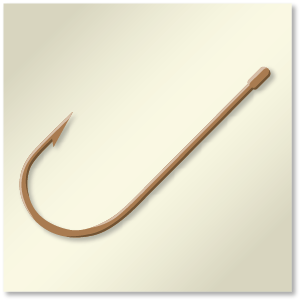
As the name says, this hook has a straight shank, and can be used for a variety of fish and baits. Though this hook can be used with plastic baits, the straight shank hook is usually used with live bait. Typical baits depending on hook size would include minnows, shiners, worms, crawdads, and crickets. The straight shank hook also comes in different styles with wider throats, heavier steel, and bent eyes.
Offset Shank
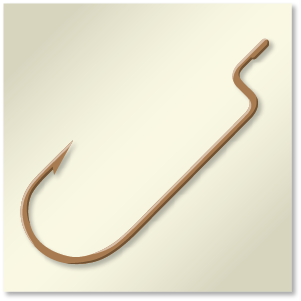
Though this hook can again be used for a variety of fish and baits, the offset shank hook was developed for use with plastic baits such as worms, lizards, or salt craws. The offset design allows the eye of the hook to be buried into the plastic bait for Texas style rigging, without interfering with the performance. Again, there are variations of this hook as well with different size offsets or special bends.
Aberdeen
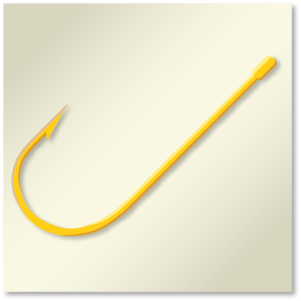
This hook has the same design as the typical straight shank hook, but is made from brass. The brass allows the hook to be used in brush or trees where snags are common. Once pulled free, the hook can be bent back to shape and reused. The Aberdeen style hook also has variations with different bends in the shank and eye for special uses.
Treble Hook
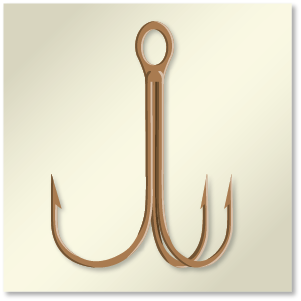
The treble hook offers the advantage of three hooks in one. Also available in steel or brass, the treble hook is used on casting baits such as crankbaits, or can be used for clumping salmon eggs for trout, or stinkbait for catfish. Large weighted treble hooks are used by anglers that snag for fish. Make sure to check Missouri fishing regulations for what type of fish can be snagged.
Weights
When fishing certain situations, a weight is needed to get the bait down, keep it in one spot, or slow the bait down through a current. There are a variety of weights available for almost every type of fishing. Almost all weights are made from lead, but some are now available in brass and other metals due to environmental considerations. Weights or sinkers range in weight from 1/32 ounce to 1/2 ounce or better.
Split Shot
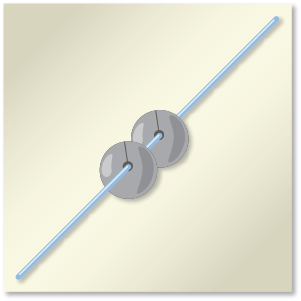
The split shot is probably the most popular of all weights. Almost every fisherman has them in their tackle boxes, or on the floor of their boats. Resembling a shot from a shotgun, the split shot weight has a slit down one side. The slit allows the shot to be crimped anywhere on the line. This type of weight is used mostly when fishing for crappie or bluegill to weigh down minnows, worms, or crickets. Simply find a desired location for the weight and crimp it on the line. Be sure to use pliers when crimping though, it’s a lot cheaper than a trip to the dentist.
Bell Sinker
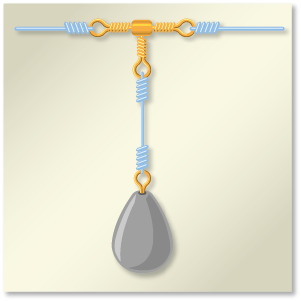
Resembling a bell shape, the bell sinker is used when one or more baited lines are attached to the main fishing line, or when making a drag rig. Usually ranging in weight from 1/8 ounce to 1 ounce, the bell sinker works well when trying to keep the bait off the bottom when still fishing or moving along a current.
Barrel Sinker
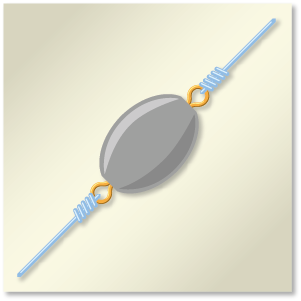
Similar to a bell sinker, the barrel sinker has eyes at both ends. As with the bell sinker, single or multiple baited lines can be used with the barrel sinker. In most cases though, the barrel sinker is used with a single line that’s cut to a determined length to keep the bait off the bottom. The added line also allows the fish to take the bait and hold it before feeling the weight. This is a great advantage to the angler. The rounded edges of the barrel sinker helps to keep the sinker from snagging on rocks or in crevices. The weight ranges of the barrel sinker are from 1/4 ounce to 8 ounces.
Buller Weight
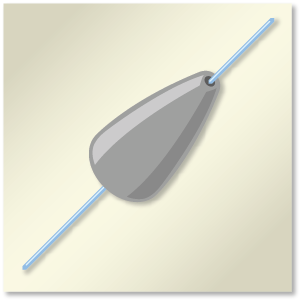
Also known as slip sinkers, the bullet weight is used mostly when fishing with plastic baits such as worms, salt craws and lizards. Ranging in weights from 1/16 ounce to 1 ounce, the bullet weight can move freely along the fishing line. When rigging a bullet weight, the line is passed through the weight, then tied to the hook. While on the bottom, the fish can take the worm without feeling the weight, giving the angler time to get ready for the hook set. The cone shape of the weight allows it to pass through vegetation, trees, and rocks. To keep the worm and weight from hanging over trees, the bullet weight is sometimes pegged to the line with a toothpick. Glass beads are also added at times between the weight and the worm to add sound when working the worm.
Lines
When fishing, the only thing between you and a hooked fish is the line. If the line pound test (or strength) is not enough, or the line is frayed, there’s a good chance the fish will be lost. Different types of line are available for different types of fishing. The most common lines used today are monofilament, fly line, and braided lines. Be sure to select the right line for the type of fishing done, and always the best buy you can afford.
Monofilament

Monofilament: Also known as just plain fishing line, monofilament is made by a number of manufacturers, and comes in a variety of pound tests, and colors. Some lines are stiff where others are limp, it’s a personal preference. As with the color of the line, it’s a personal thing, but some colors are easier to see by anglers and fish. A consideration when selecting a line is that higher quality lines will resist abrasion and stretching better than cheap lines. Also, be sure to use proper knots when tying on baits or lures. A bad knot can make the line cut itself and remember to retie the knot often. If any abrasion is noticed, it’s time to retie the knot. To protect monofilament, try to keep out of the direct sunlight when storing your rods and reels. Also, avoid contact with petroleum products such as gasoline.
Fly Line

Made from a soft plastic, fly line comes from a number of manufacturers, and is available in a variety of weights and colors. Unlike monofilament, fly line has weight to it, allowing the angler to cast light flies and baits. Fly line comes in two types, floating and sinking. The type of line depends on the kind of fishing done. Also, almost all fly lines are tapered at the end for easier tying of the leader which is then tied to the fly or bait. Visiting a fly fishing shop will help you to understand everything you need to know about fly lines.
Braided Line

Similar to the braided lines of the past, braided lines today use different materials, manufacturing processes, and are thinner in diameter. Braided lines will virtually last forever, do not stretch, and are thinner compared to the test ratio of monofilaments. As an example, a 30 pound test braided line has about the same diameter as 14 pound test monofilament. The Palomar knot is the most popular knot used when tying braided line to lure. The only real drawbacks to using braided lines are the high cost, cutting the lines, and knot tying. Improvements and tools are being made to help anglers in using these lines.
Wire Line

Wire fishing line is made of stainless steel and is used mostly for trolling or leader material. It is difficult to cast but works well when fishing for fish with teeth, The wire line is available in single strand or multi-strand in which case is braided. Popular knots used when using wire fishing line are Palomar, snell, uni and figure eight.
Knots
When fishing, the only thing between the line, bait and fish is the knot. A good knot is essential to help ensure that you can land the fish. Along with the fishing line, knots take a lot of abuse from stretching and coming in contact with logs and rocks. Below are two of the most popular knots used.
Improved Clinch Knot
One of the most common knots used to tie the fishing line to the hook or lure is the Improved Clinch Knot. It’s a very strong knot and is easy to tie and works well with monofilament line. With practice, the Improved Clinch Knot can be easily tied in the dark. Click on the + to see how the knot is tied.
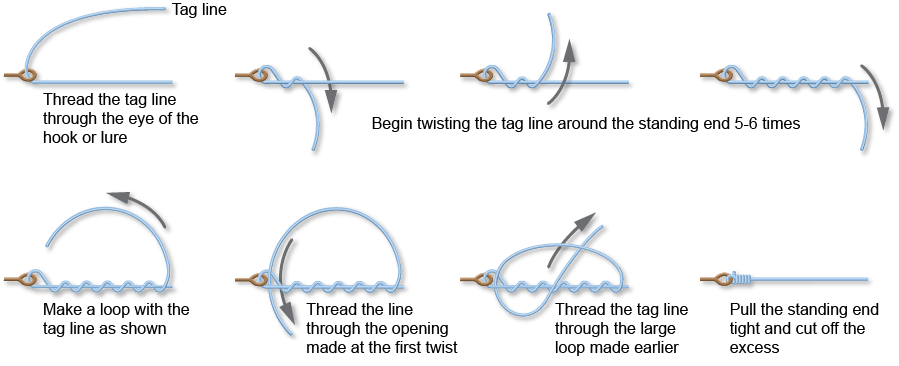
Palomar Knot
Another common knot is the Palomar knot. It’s a strong knot and is easy to tie and works well with monofilament, braided and wire lines. With practice, the Palomar can be easily tied in the dark. Click on the + to see how the knot is tied.
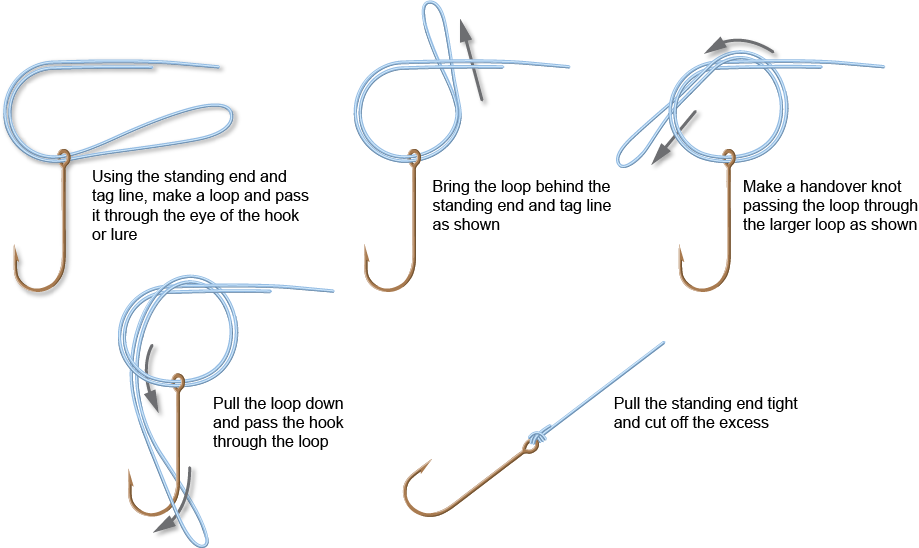
Floats
When fishing bait, live or not, there are many times when the bait needs to be held just off the bottom or suspended at a certain depth. This is where the float or bobber come into play. Just for information, there are probably just as many styles of floats as there are hooks. The floats that are illustrated are the most common ones used. They are the Ball Bobber, Slip Bobber, and Spring Bobber.
All three floats can be used for catching a variety of fish and are used in different ways. Most commonly, floats are associated with panfish such as bluegill or crappie but are also used for trout when using salmon eggs or jigs, and bass when using large shiners. The type of fishing done, and bait used may determine which float to use.
Floats come in different sizes, colors, and materials. In most cases, which one to use is a personal preference. You may find though that some floats work better under certain situations. The size float to use will depend on the size of the bait used and the fish you’re after. As far as color, it’s best to find a color that you can see whether the skies are clear or cloudy. For materials, there is plastic, foam, or wood. Plastic is good, but a couple of hits on the rocks, or if they’re stepped on, the float is useless. Foam is an excellent choice. They’re durable and maintain their buoyancy. Wood floats are still made, but for the most part, is reserved for specialty floats.
Ball Bobber
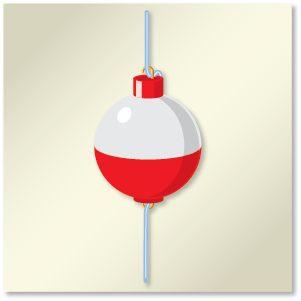
This is probably the most common float used. The ball bobber comes in a variety of sizes and colors and can be found in plastic or foam. The float is easy to use, just press on one side and a spring loaded hook comes out to attach to the line. The spring loaded hook allows the float to be adjusted on the line, depending on the depth needed, or removed if no longer needed. The ball bobber can be used red or white side up.
Slip Bobber
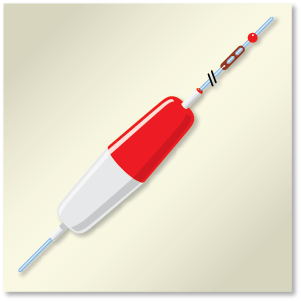
The slip bobber is unique from all other bobbers in the way that it is used. Unlike other floats that are attached directly to the line, the slip bobber uses a bobber stop and bead, and has a hollow stem that the line passes through. The bobber stop, which is threaded on the line, can slide up or down depending on the depth your fishing. The bead is used to keep the bobber stop from passing through the slip bobber stem. The advantage of the slip bobber is that you can reel almost all the line in before casting, and not have 6, 8 or 10 feet of line hanging out. Once cast, the hook, bait, and sinker pull the line through the bobber until it reaches the stop. If you need to fish deeper, slide the stop higher up the line. The slip bobber is great when teaching children to fish.
Spring Bobber
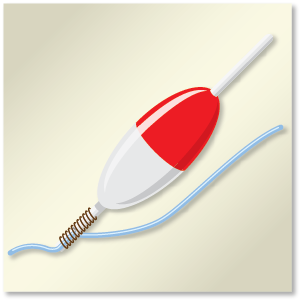
The spring bobber, like the ball bobber is another popular float for panfish. The design of the spring bobber allows the line to be attached on a stem below the float, which puts the connecting point below the water surface. This allows for greater stability and more sensitivity in the float. As with other floats, the spring bobber comes in many colors, sizes, and can be found in plastic or foam.
Weighted Float
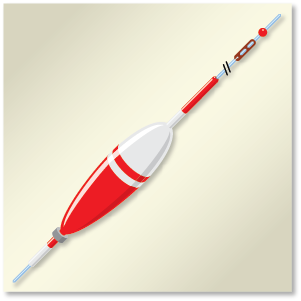
The weighted float is similar to the other bobbers and floats but with the unique feature of added weight. It may seem strange to have weight added to a float, but there are advantages. The weights on these floats are added to the inside or the outside depending on the design. Weighted floats with a similar design to the ball or spring bobber will have weights on the inside. Floats similar to the slip bobber will have weights attached to the outside as shown in the illustration.
Advantages of the weighted float are the distance it can be cast, and the weight of the bait or lure used. Longer casts may be needed when fish need to be approached from a distance and when casting into the wind. When fishing with very light jigs or baits, it can at times be difficult to make a cast even with light equipment. A weighted float can be used to cast even the smallest jigs and baits using standard fishing gear.
Weighted floats are available in many sizes, weights, and designs. If you have never used a weighted float, give it a try.
Swivels
Swivels are a must have for any tacklebox and can make fishing and rigging lures and baits easier. Swivels have been around for a long time and are probably the most versatile piece of fishing tackle as their uses are endless. The swivels illustrated below, are the most common ones used. They are the Barrel Swivel, Snap Swivel, Three-way Swivel and Wire Leader.
Swivels are available in many sizes and can be made from either brass, stainless steel or nickel. Swivels can be used to eliminate line twist, change baits and lures quickly or when needing multiple connecting points. It’s also important to use the right swivel for the type of fishing you’re doing.
To better understand the different swivels available and how they can be used, Explore the swivels below.
Snap Swivel
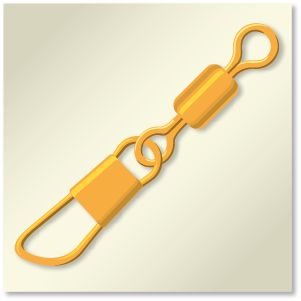
The snap swivel is great when you find that you’re changing baits and lures often. The snap swivel has a barrel shaped body with a ring on one side and a snap on the other. Though the snap swivel can be used to eliminate line twist, it’s better used for changing lures or baits quickly. This saves time, eliminating cutting and retying fishing line. Snap swivels are often used when fishing with crankbaits.
Barrel Swivel
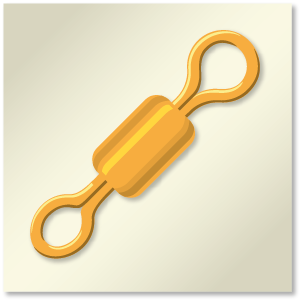
The barrel swivel is the most common swivel available and used. With a barrel shaped body and a ring on either side, the barrel swivel can be used to eliminate line twist when using lures that rotate. The barrel swivel can also be used when wanting to use different lengths of line or allowing a bait to float when paired with a weight. Barrel swivels are also available with ball bearings for better spinning properties.
3 Way Swivel
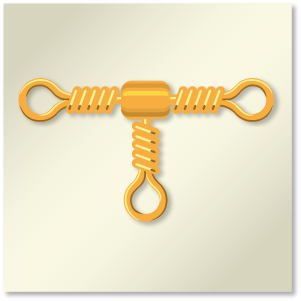
The 3-way swivel, sometimes referred to as a cross swivel, is used when multiple connecting points are needed. An example includes drift rigs where one ring is attached to the line, another to the bait, and the third to a bell sinker (See Lure and Bait Rigging). This type of rig can be used for stationary fishing or trolling when you want to keep the bait or lure deep near the bottom.
Wire Leaders
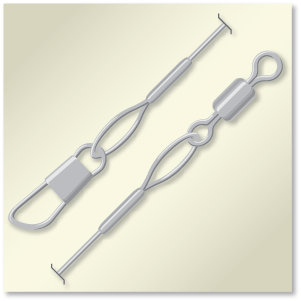
The wire leader has been included in this section because of the use of barrel and snap swivels. Wire leaders come in different lengths and diameters depending on the fish being caught. Wire leaders are used mostly when fishing for Muskies and Northern Pike or any fish with teeth. Fish with teeth can easily cut monofilament or braided line, the wire leader prevents this. The fishing line is attached to the ring or barrel swivel side of the leader with the lure attached to the snap swivel side.
